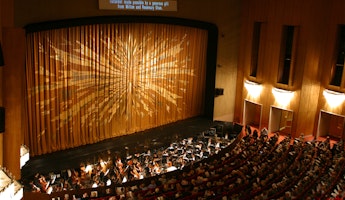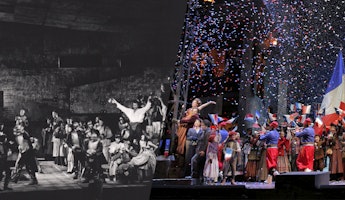Blog
September 14, 2022
James Conlon on "Lucia di Lammermoor"
Lucia di Lammermoor: A Refracted Light of Her Time, and Ours
“Every thing is what it is, and not another thing”
(Joseph Butler, 18th-century English theologian)
Why do we need Lucia di Lammermoor, her tragic story and her dark and dreary Scottish castle? Gloom notwithstanding, it is the most popular opera by Gaetano Donizetti (who lived from 1797 to 1848). It has never left the world stage since its premiere in 1835.
A prejudice of our time suggests that only the works of composers who revolutionized music by completely breaking with tradition, or who pushed their genre toward a markedly new stage of formal development, are interesting. Yet Donizetti, who has endured, wrote completely within the formal framework of the Italian operatic tradition as he received it, without demonstrating any apparent dissonance between that tradition and himself.
Music is most often a combination of these distinctions, but there is a large distance between the reflective nature of Schubert and Schumann lieder, expressing sentimental longing, and the directness and apparent spontaneous nature of the music of the bel canto composers—Gioachino Rossini (1792-1868), Donizetti and Vincenzo Bellini (1801-1835)—which neither comments on itself nor the composers' selves from a subjective reflective position.
Of Donizetti’s 70 operas, 61 are melodramas or tragedies. He succeeded Rossini as the next great exponent of melodrama in the first half of the 19th century. By the time Donizetti died in 1848, Giuseppe Verdi (1813-1901) had taken up that mantle and would gradually elevate the operatic form through his gradual modification of the bel canto forms to its completion. He subsequently surpassed it to create the zenith of Italian opera.
Through the alchemy of his music, Donizetti transformed Sir Walter Scott’s cold melancholy Scotland into a hotbed of Mediterranean passion. Scotland (the “Wild North”) was to England and continental Europe what the “Wild West” was to North Americans. It was perceived as remote and barbaric, fascinating and terrifying. A perfect backdrop for mad passion or passionate madness.
Like most composers, Donizetti was attracted to those elements in a story that would translate well into his muse. The "romantic" elements for an opera needed to be contained therein. First it required a distribution of vocal roles according to convention: an ultimately tragic soprano and tenor who are in love, a baritone who opposes that love (in this case the domineering brother of the soprano) and a bass who represents authority and age (in this case the soprano's minister and guardian). The setting in a remote century (early 18th) and country (Scotland) conforms with contemporary convention. That the subject was based on flawed and inaccurate history was of little importance to most composers, including Donizetti, as long as the plot could serve a necklace-like succession of scenes (following conventional dictates) that could be strung together. Hundreds of such operas were written, although only a fraction have survived.
In 2005, I wrote the preface to a book entitled La folie à l’opéra (Madness in Opera) written by three French authors, two of whom were psychologist-musicologists. It was a 500-page volume, published in Paris, which took an intriguing tour through the subject, from the Baroque era to the present day. This book came to mind as I reviewed Lucia di Lammermoor. The authors cautioned that the terms “mad” or “crazed” should not be understood as a clinical state but rather should be applied to individuals who have been profoundly estranged from their social environment. The point of departure for my preface was that music, which exists on the thin borderline between transcendence and concrete reality, was exceptionally well served by its proximity to fantasy. Music both inspires and is inspired by fantasy. In the Classical period, piano fantasies emerged from the boundaries of stricter rigorous compositional forms (sonata, fugue, theme and variations, liturgical) into an acceptable and apparent “formlessness.” In opera, “madness” provided a dramaturgically justifiable pretext for such formlessness, one that afforded the composer an opportunity to break free from formal restraints.
By the time he composed Lucia, Donizetti had already created three mad scenes for earlier operas and subsequently was to write two more. In an irony worthy of Pushkin (whose Eugene Onegin dies in a duel, foreshadowing the author’s own death), Donizetti would suffer from mental derangement in his final years, expiring in a state of psychosis.
The composer employed a rare musical instrument to accompany Lucia through her delusional final scene: the glass harmonica, first popularized by the Irish musician Richard Pockrich in the 1740s. Gluck played a similar instrument, and Handel, Mozart, Beethoven and Richard Strauss all composed for it. Benjamin Franklin created his own version of it, which can be seen today at the Franklin Institute in Philadelphia. In recent years, this instrument has enjoyed a revival of interest by contemporary composers.
Donizetti’s use of the glass harmonica is virtually unique in opera. Significantly, the device was alleged (without any scientific proof) to cause madness in those exposed to it, both musicians and audiences. (Subsequent hypotheses suggest that those who played the glass harmonica may have suffered from lead poisoning, caused by moistening the thumb, and rubbing it against the glass, which produces the sound). This may have first prompted Donizetti to use the glass harmonica in Lucia’s "mad" scene. It seems his original intent was thwarted when the most competent player at the time refused to play at the Teatro San Carlo, alleging that the theater had never paid him for his services on a previous occasion. The composer transferred the extensive musical passages to the flute, there to remain until recent decades when, in the spirit of historical accuracy, the use of the glass harmonica in performances of Lucia has come back into fashion.
Did Donizetti think about the sociological relevance of his opera? I doubt it. But we can easily see its power to address the core of the tragedy, and to a subject which should still prompt moral outrage today.
The plight of Lucia is that of a young woman forced into an unwanted marriage, while being prevented from the marrying the man of her choice. She is, of course, a victim of a society that used their daughters (and sons) as commerce, pawns to be traded for the social, financial and political advancement of already privileged families.
Even without the glass harmonica, Lucia and her passion-inspired madness became influential in literature, taking on lives of their own. Significant passages about the opera and its heroine appear in Gustave Flaubert’s Madame Bovary (1856), Leo Tolstoy’s Anna Karenina (1877) and E.M. Forster’s Where Angels Fear to Tread (1905). Why is that? Is it because, as well as victim, she is a heroine of self-determination? She resembles the biblical Judith who "executes" Holofernes, saving herself and her people. Judith murders, but her lawyers need not plead insanity. She can be seen as an avenging angel of one of society's fundamental sins.
Much of the modern world condemns forced marriage, and judges it a violation against our modern concept of human rights. It finds the notion unacceptable that society has a right to prevent individuals from marrying each other who wish to do so. Turn on the television, open any newspaper or check social media if you think Lucia's plight and story lacks relevance.
While recognizing that these sociological issues were not on Donizetti's mind, Lucia di Lammermoor speaks to our time. That it does so hardly changes the fact that its raison d'être was its melodramatic plot and its ideal vehicle for the compositional grace of its genius, Gaetano Donizetti.
Lucia di Lammermoor justifies itself as a beautiful artifact of its time. It is important precisely because it is not of our time. By being itself (not like ourselves), it serves as a foil and better clarifies us to ourselves. Revolutionary or not (and Lucia wasn’t) it fulfills its fundamental function as a bel canto opera, whose first and overriding obligation is (by definition) to be a theatrical forum for beautiful singing: beautiful in its design and in its very nature. Like a Beethoven sonata or a Haydn symphony it is both timeless and of its time and exists independently of any (perhaps irrelevant?) discussion of its relevance. On those terms, Lucia di Lammermoor, with its gloomy castle, is hardly irrelevant. It renders our world more beautiful, and in a world that needs beauty in all its forms more than ever, it is absolutely not expendable.
© James Conlon
(revised 2022)








/03-cosi/_dsc0996_pr.jpg?format=auto&fit=crop&w=345&h=200&auto=format)
















